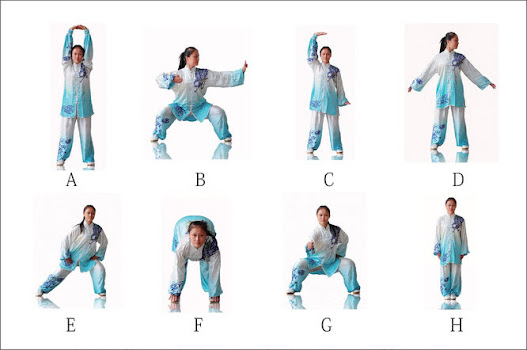The Eight Brocades are possibly the most practiced set of Qigong forms. These are considered Medical practices, rather than Spiritual or Martial.
Silk, especially white silk, is symbolic of purity and softness. The movements of the Eight Brocades are smooth and flowing.
As we practice, we focus on breathing, stretching and contracting, and of course mindfulness. The health benefits include increased joint mobility, structural stability, focus of the mind and gentle nourishment of Qi.
There are various interpretations of the movements, some simple, some slightly more complex. I have included videos of Mimi Kuo Deemer and of Shi Heng Yi of the Shaolin Temple. Both are quite beautiful.
Two Hands Support the Heavens This move stimulates the "Triple Heater" (Sanjiao) Meridian. The Triple Heater is the body’s thermostat. The hands move upward, interlacing at the level of the forehead and reach, palms up, towards the sky. The hands lower out to the sides.
The Triple Heater regulates our body temperature. Emotionally, the Triple Heater supports how we interact with ourselves and others. If it is out of balance we may feel aloof or on the opposite end of the spectrum, too friendly, too eager to please. By lowering our hands to the sides we are defining the outer boundary of our Wei Qi, our defensive “field” keeping physical and emotional pathogens at bay.
Drawing the Bow and Letting the Arrow Fly While in a lower horse stance, we draw a bow to one side and then the other. This action focuses our attention on the waist area, the kidneys and spleen.
The acting of drawing a bow is done with great intention and aim using the eyes to set our intention. Yi. Traditional Chinese Medicine (TCM) speaks of the eye as being the sense organ of the liver. The liver balances anger and action. drawing the bow takes place at the level of the heart, cultivating clear direction.
Separate Heaven and Earth This has become on of my favorite forms. We raise and lower our hands simultaneously reaching for the sky and the earth. One hand reaches upwards, the other downwards, palms facing the sky and the earth. The hands are then lowered back down towards the solar plexus and trade positions.
In a previous blogpost I wrote about reaching for the rising heat and downwards to the falling coolness and bring them back together to create balance. Yin and Yang. We are also strengthening the Qi of the stomach and spleen. If the stomach and spleen Qi is out of balance we may feel anxious and may over-analyze.
- A diagram published by Roger Jahnke
While practicing this form, I anticipated a question. What are the 5 fatigues and the 7 illnesses? In Taoism the head is considered to be the home of the inner gods, which I think of as intuition. I welcomed my fellow practitioners to come up with their own list of 5 fatigues and 7 illnesses. Each person will have a different list.
Sway the Head and Shake the Tail This is said to regulate the function of the heart and lungs. The primary aim is to remove excess heat (xin huo) from the heart. Xin huo is associated with heart fire in TCM. We squat in a low horse stance, places the hands on thighs with the elbows facing out and twists to glance backwards on each side.
By calming heart fire (xin huo) we are cultivating a sense of kindness and harmony. Or, as it’s called in Buddhism, Meta, loving kindness.
Two Hands Climb the Legs to Strengthen the Kidneys and Waist By placing our hands on the lower back we are drawing our intention to the kidneys which are considered to live in the water center. . The hands lightly move down the back of the legs to the feet, circle around and climb back up the inner legs to the Dan Tian and then up along the chest, passing the forehead and up to the sky.
We are gently massaging the kidney and bladder meridians which are related to the water element. By balancing the water element we are cultivating inner stillness, plus inner strength, and also ease, Wu Wei, effortless action.
Punch the Fists with and Angry Gaze. What? Anger in a Qigong practice? Anger is a natural emotion. If it is suppressed it can become destructive. While in a horse stance we punch forward first with one fist and then the other.
Anger can be either destructive or constructive. Destructive anger causes us to lash out and potentially cause harm. Constructive anger is fuel to create positive change. I invite practitioners to create a soft relaxed fist with the hopes that this will create a sense of constructive anger.
Bouncing on the Toes We bend forward starting by lowering the head, then curling down the spine until we are dangling towards the earth. Then, we roll back up and bend backwards, but only slightly. We then stand erect, being supported by the Bai Hui, the crown of the head.
Then we lift up onto our tiptoes hold for a breath and then drop the heals back down quickly creating a vibration and a slight rocking motion. The gentle shaking vibrations smooth out the Qi while also strengthening bone density. Mimi Duo Deemer uses the visual example of filling a jar with flour, then tapping it gently to let the flour settle.
Enjoy!



No comments:
Post a Comment